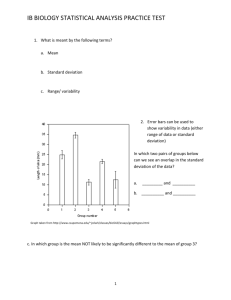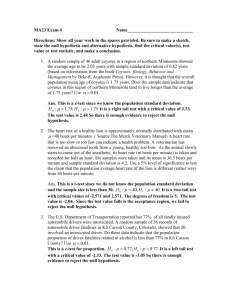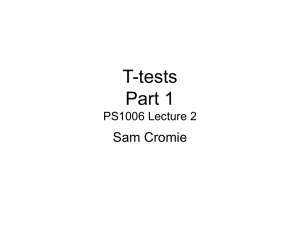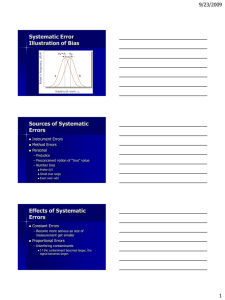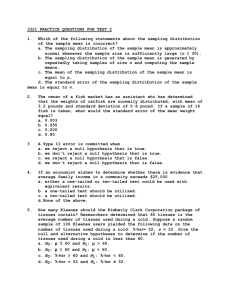Biology Statistics Worksheet: Mean, SD, and T-Tests
advertisement
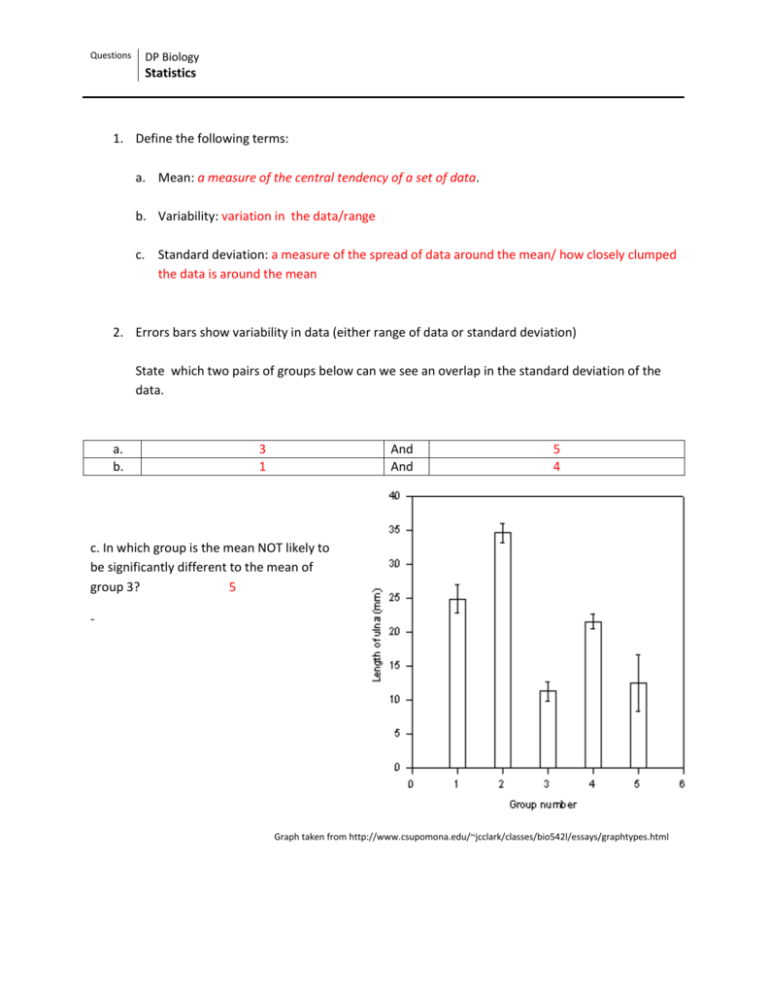
Questions DP Biology Statistics 1. Define the following terms: a. Mean: a measure of the central tendency of a set of data. b. Variability: variation in the data/range c. Standard deviation: a measure of the spread of data around the mean/ how closely clumped the data is around the mean 2. Errors bars show variability in data (either range of data or standard deviation) State which two pairs of groups below can we see an overlap in the standard deviation of the data. a. b. 3 1 And And 5 4 c. In which group is the mean NOT likely to be significantly different to the mean of group 3? 5 - Graph taken from http://www.csupomona.edu/~jcclark/classes/bio542l/essays/graphtypes.html 3. On the axes below, plot the following three curves (all have a normal distribution): a. Has the highest mean and a high standard deviation. b. Has the lowest mean, but the highest frequency at that mean. c. Has a mean between (a) and (b) and has the smallest standard deviation. 4. Complete the following paragraph: ± 1 (standard deviation) from the mean represents _68 % of all the data points. In data with a high standard deviation, data are clustered closer to/ further from the mean. In data with a low standard deviation, data are clustered closer to/ further from the mean. Overlapping standard deviations suggest two datasets are/are not significantly different. _95 % of all data fall within 2 standard deviations of the mean. Group A Group B 24 25 26 23 25 25 26 27 23 23 24.7 24 29 25 23 29 32 34 31 32 29 28.8 1.418136 3.705851 6. Calculate the means and standard deviations of these two groups of data (to one decimal place) Show your working here. Mean Stdev P= 0.004 (T-Test) 7. In a t-test comparing Group A and Group B, the P value was calculated as 0.004. What does this P value tell us about these two sets of data? The two sets of data are significantly different Explain your answer. The P value is less than 0.05. The data are less than 1% similar, therefore 99% dissimilar 8. Why does the scientific community place so much importance on significance tests such as the t-test? We are dealing with a small sample size and need to make sure that this is representative of the whole population 9. Use the t-table shown to perform the t-tests with these examples. Make sure you follow conventions and write everything down correctly each time. a. Which confidence limit do we normally choose in Biology? 95% b. A student measures 15 snail shells on the north side of an island and 16 on the south. H0 = There is no significant difference in the size of shells from the North and South of the Island Confidence = 95% DF (number of samples -2) = 29 Critical value = 1.699 t is calculated as 1.02. So we reject/accept Ho. Conclusion: There is no significant difference in snail shell size c. A student measures the resting heart rates of 10 swimmers and 12 non-swimmers. t is calculated as 3.65. So: t value is greater than the critical value of 1.725, Conclusion: We therefore reject the null hypothesis and accept that the data is significantly different 10. A researcher is investigating the link between air pollution and egg size in chaffinches. She measures the diameters of eggs at 8 sites near a factory and 9 sites out of town. The mean egg diameter by the factory was 5.6cm, whereas it was 7.4cm out of town. t is calculated as 2.08 So: Critical value is 1.753. The t value is greater than the critical value. Conclusion: We reject the null hypothesis and accept that the diameter of the eggs at the two sites are significantly different. 11. A doctor is testing the effectiveness of two kinds of antiseptics against bacterial cultures. He sets up six samples with antibiotic 'A' and six with antibiotic 'B' and after 2 weeks counts the numbers of bacteria present in each. Mean counts: A = 5.6x104cells; B = 5.7x104cells. t is calculated as 1.97 So: t value is greater that the critical value 1.81 Conclusion: We reject the null hypothesis and accept that the effectiveness of the antibiotics are different. 12. A recent study looking into male fertility found that men who drank 3 cups of coffee a day showed signs of more sperm tail damage (39.1% of sperm) than those who did not (32.8%). 22 men sampled drank no coffee. 18 drank 3 or more cups a day. t is calculated as 3.35 So: t value is greater than the critical value of 1.68. Conclusion: We reject the null hypothesis and accept that coffee has a significant impact on sperm tail damage 9. Look at the graph below: 13. Identify the true statements, according to the graph: a. There is no correlation between number of cellphones and number of students with asthma. b. There is a positive correlation between number of cellphones and asthma cases. c. There is a negative correlation between number of cellphones and asthma cases d. Increased numbers of cellphones cause an increase in numbers of students with asthma. e. Increased numbers of asthmatic cause increased numbers of cellphones in a school. f. There is no evidence of causality in this graph. 14. Suggest two comparisons in which a causal relationship is likely (e.g. temperature and rate of reaction). Alcohol consumption and liver damage Sun exposure and skin cancer Size of leaf and light intensity
